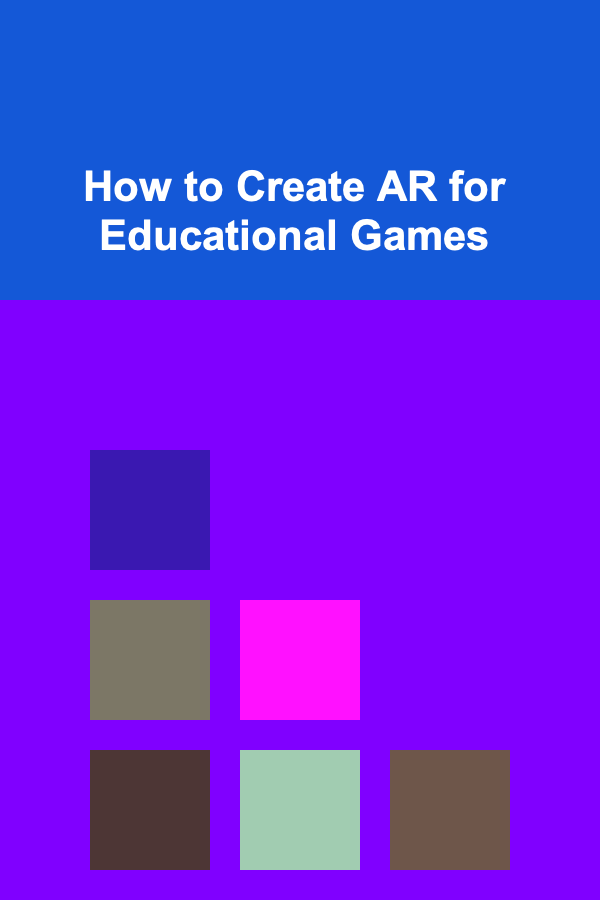
How to Create AR for Educational Games
ebook include PDF & Audio bundle (Micro Guide)
$12.99$6.99
Limited Time Offer! Order within the next:

Augmented Reality (AR) has become one of the most exciting and transformative technologies in the world of education. By blending the digital world with the real one, AR offers a unique way to engage students, enhance learning experiences, and make education more interactive and enjoyable. One of the most innovative uses of AR in education is in the development of educational games. These games not only make learning fun but also provide immersive experiences that help reinforce learning concepts in ways that traditional methods cannot.
Creating an AR-based educational game requires a blend of technology, creativity, and a deep understanding of both game development and educational pedagogy. This article will explore the key components involved in creating AR for educational games, from understanding the basics of AR and its impact on learning to practical steps in the development process.
Understanding Augmented Reality
Before diving into the creation of AR educational games, it's essential to understand what augmented reality is and how it works.
What is Augmented Reality?
Augmented Reality (AR) is an interactive experience where real-world environments are overlaid with computer-generated content. Unlike Virtual Reality (VR), which creates entirely simulated environments, AR enhances the user's real-world perception by adding virtual elements. These virtual elements can be in the form of images, videos, sounds, or even 3D objects that seem to exist in the physical world.
The most common AR experiences are available on mobile devices, where the camera captures real-world surroundings, and AR content is superimposed onto the screen. In educational settings, AR can bring textbooks, diagrams, historical artifacts, or abstract concepts to life.
How AR Works
AR works through a combination of hardware (like smartphones, tablets, and AR glasses) and software (AR development platforms and apps). AR uses several technologies to create its magic, including:
- Sensors and Cameras: These detect and capture the physical environment. Sensors like accelerometers and gyroscopes help track the movement and orientation of the device.
- Processing: Software processes the data collected by sensors to determine how to position and display virtual content relative to the real-world environment.
- Projection: The virtual content is projected onto the real world, either on the device screen or through a more advanced AR setup like smart glasses.
- Reflection: For AR devices like glasses, special mirrors or displays help reflect the augmented content back into the user's eyes.
In the context of educational games, AR can be used to make learning more interactive by allowing students to engage with digital content that interacts with their physical environment.
The Impact of AR on Education
AR has the potential to revolutionize education by providing learners with a more engaging and immersive experience. Here's how AR enhances the educational process:
Increased Engagement
AR brings learning to life by providing students with interactive and visually stimulating experiences. When used in educational games, it can captivate students' attention and make learning more enjoyable. For example, students can learn about the solar system by exploring 3D planets floating around them or participate in a historical reenactment using AR to interact with historical figures.
Enhanced Understanding of Complex Concepts
AR can simplify complex subjects by visualizing them in ways that traditional methods cannot. Subjects like geometry, physics, and biology, which often require abstract thinking, can be better understood when students can see and manipulate 3D models in their real environment.
Personalized Learning
AR can be tailored to individual learning needs. Games can adapt in real-time, offering customized challenges based on a student's progress, thus fostering personalized learning. Whether it's adjusting difficulty levels, providing hints, or offering alternative learning paths, AR ensures that every student's learning experience is unique.
Promotes Active Learning
Unlike traditional teaching methods, which may rely heavily on passive learning, AR-based educational games encourage active participation. Students are not just observing information; they are interacting with it, making decisions, solving problems, and engaging in hands-on learning.
Steps to Create AR for Educational Games
Creating AR for educational games is an intricate process that requires knowledge of both game development and AR technologies. Below are the essential steps to consider:
1. Conceptualizing the Game
The first step in developing an AR-based educational game is to conceptualize the game and its objectives. This phase involves determining the subject matter, the target audience, and the desired learning outcomes. You should ask yourself:
- What educational goals do I want to achieve? (For example, teaching history, math, science, or language.)
- Who is my target audience? (Students, age groups, learning levels.)
- What concepts do I want to visualize through AR? (Interactive objects, 3D models, environments, etc.)
- What kind of gameplay will engage learners? (Puzzle-solving, exploration, storytelling, etc.)
This stage is crucial because it sets the foundation for the entire project. A clear educational objective will guide the design and gameplay mechanics.
2. Choosing the Right AR Development Tools
Once the concept is in place, it's time to choose the right tools and platforms for creating the AR experience. There are various AR development platforms and SDKs (Software Development Kits) available, each offering different features and capabilities. Some popular AR development tools include:
- ARCore (by Google): A powerful SDK for Android that enables AR capabilities like motion tracking, environmental understanding, and light estimation.
- ARKit (by Apple): ARKit is Apple's AR development platform for iOS that supports object detection, face tracking, and 3D model integration.
- Vuforia: A widely-used AR platform that works across multiple devices and provides features like image recognition, object tracking, and cloud-based AR experiences.
- Unity with AR Foundation: Unity is a popular game development engine, and when combined with AR Foundation, it allows you to create cross-platform AR applications that work on both Android and iOS.
These tools offer various features such as motion tracking, scene recognition, and object interaction, which are essential for creating a seamless AR experience.
3. Designing the Game Mechanics
Next, you need to design the core gameplay mechanics. Educational games should strike a balance between being fun and effective in delivering educational content. Some important factors to consider:
- Game Type: What type of game are you creating? A quiz game, a puzzle-solving game, an adventure game, or a simulation-based game? Choose a format that best aligns with the educational objectives.
- Learning Progression: Design levels or challenges that gradually increase in difficulty to promote learning and skill development. For instance, in a math game, you could start with basic addition and progress to more complex algebraic problems.
- Rewards and Feedback: Incorporate a reward system that motivates students. Rewards could be in the form of points, badges, or unlocking new levels. Instant feedback helps reinforce learning and encourages students to keep progressing.
- Interactivity: The heart of AR-based games is interaction. The game should encourage users to manipulate digital objects, explore their surroundings, or collaborate with others in solving tasks.
The gameplay mechanics should be designed with the educational content in mind. A good educational game provides a meaningful learning experience while still offering engaging gameplay elements.
4. Developing the AR Content
The AR content itself is crucial for the success of the game. This step involves creating and integrating the 3D models, animations, and interactive objects that will be overlaid on the real world.
- 3D Models and Objects: These are the digital elements that students will interact with. For example, in a biology game, 3D models of organs or cells can be viewed and explored in detail.
- Audio and Visual Effects: Sounds, music, and visual effects can enhance the immersive experience. For instance, when a player successfully solves a problem, a congratulatory sound or animation could trigger.
- User Interface (UI): The UI should be simple and intuitive, especially for younger users. Clear buttons, menus, and instructions can guide the user through the game.
5. Testing and Iteration
Once the initial version of the game is developed, it's time for rigorous testing. During this phase, it's essential to check the following:
- AR Accuracy: Ensure that the AR content aligns correctly with the real-world environment. For instance, 3D objects should appear to sit naturally on surfaces like tables or floors.
- Usability: Test the game's user interface to ensure it is easy to navigate, especially for young learners or those with limited technology experience.
- Performance: Test how the game performs across different devices. AR applications can be demanding on hardware, so optimizing performance is essential.
- Educational Effectiveness: Ensure that the game successfully teaches the intended concepts. Conduct user testing with your target audience to gather feedback on how well the game meets educational goals.
Based on feedback, iterate on the design and gameplay to refine the experience. Continuous testing and iteration ensure that the game is both fun and educational.
6. Deployment and Distribution
After testing, the final step is to deploy and distribute the game. You can distribute your AR educational game on various platforms, such as:
- App Stores (Google Play and Apple App Store): Make your game available to a wider audience by publishing it on mobile app stores.
- Educational Institutions: You may also partner with schools, universities, or educational platforms to distribute your game directly to educators and students.
- Web-Based AR: Consider creating a web-based AR game that can be played directly in a browser using WebXR, which eliminates the need for an app download.
It's essential to promote the game effectively so that educators, parents, and students are aware of its existence and value.
Challenges and Considerations
While developing AR educational games is an exciting venture, it comes with its own set of challenges:
- Device Compatibility: AR apps can be resource-intensive, and not all devices have the necessary hardware to support them. Ensuring compatibility across various devices is crucial.
- Accessibility: The game should be accessible to all students, including those with disabilities. Consider providing audio cues, captions, or other assistive features.
- Cost and Resources: Developing AR games can be expensive, requiring both time and skilled developers. It's important to budget accordingly and, if possible, collaborate with educational institutions or partners.
Conclusion
Creating AR-based educational games is a powerful way to enhance learning and engage students in new and exciting ways. By combining the immersive capabilities of AR with the proven effectiveness of educational games, developers can create experiences that are both fun and educational. From conceptualization to deployment, the process involves careful planning, collaboration, and continuous iteration to ensure that the final product is both engaging and educationally effective. As AR technology continues to evolve, the potential for even more innovative and impactful educational games will grow, offering new opportunities to enrich the learning experience.

How to Create a Family Scavenger Hunt Indoors
Read More
How to Ensure Your Website is Mobile-Friendly: A Complete Checklist
Read More
How to Save Money on Groceries with a Home Budget
Read More
How to Use DIY Ornaments to Add a Personal Touch to Your Tree
Read More
How to Understand Capital Gains Tax
Read More
Mastering the Art of the Oversized Blazer: A Style Guide
Read MoreOther Products

How to Create a Family Scavenger Hunt Indoors
Read More
How to Ensure Your Website is Mobile-Friendly: A Complete Checklist
Read More
How to Save Money on Groceries with a Home Budget
Read More
How to Use DIY Ornaments to Add a Personal Touch to Your Tree
Read More
How to Understand Capital Gains Tax
Read More